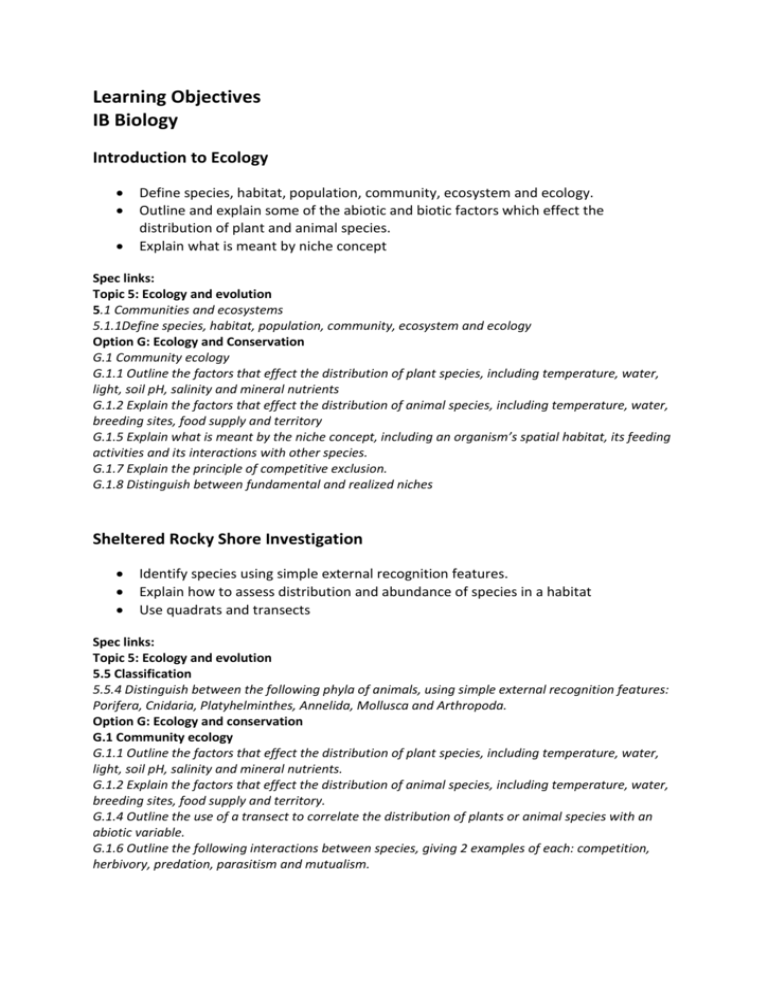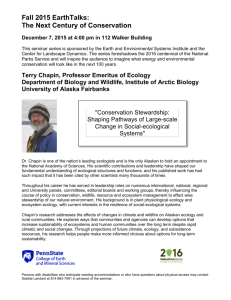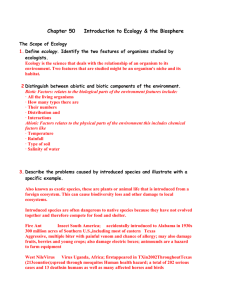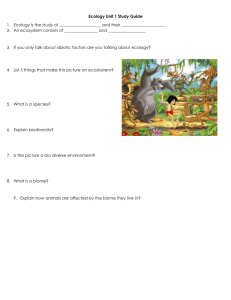IB Biology - Field Studies Council
advertisement

Learning Objectives IB Biology Introduction to Ecology Define species, habitat, population, community, ecosystem and ecology. Outline and explain some of the abiotic and biotic factors which effect the distribution of plant and animal species. Explain what is meant by niche concept Spec links: Topic 5: Ecology and evolution 5.1 Communities and ecosystems 5.1.1Define species, habitat, population, community, ecosystem and ecology Option G: Ecology and Conservation G.1 Community ecology G.1.1 Outline the factors that effect the distribution of plant species, including temperature, water, light, soil pH, salinity and mineral nutrients G.1.2 Explain the factors that effect the distribution of animal species, including temperature, water, breeding sites, food supply and territory G.1.5 Explain what is meant by the niche concept, including an organism’s spatial habitat, its feeding activities and its interactions with other species. G.1.7 Explain the principle of competitive exclusion. G.1.8 Distinguish between fundamental and realized niches Sheltered Rocky Shore Investigation Identify species using simple external recognition features. Explain how to assess distribution and abundance of species in a habitat Use quadrats and transects Spec links: Topic 5: Ecology and evolution 5.5 Classification 5.5.4 Distinguish between the following phyla of animals, using simple external recognition features: Porifera, Cnidaria, Platyhelminthes, Annelida, Mollusca and Arthropoda. Option G: Ecology and conservation G.1 Community ecology G.1.1 Outline the factors that effect the distribution of plant species, including temperature, water, light, soil pH, salinity and mineral nutrients. G.1.2 Explain the factors that effect the distribution of animal species, including temperature, water, breeding sites, food supply and territory. G.1.4 Outline the use of a transect to correlate the distribution of plants or animal species with an abiotic variable. G.1.6 Outline the following interactions between species, giving 2 examples of each: competition, herbivory, predation, parasitism and mutualism. Saltmarsh Investigation Distinguish between primary and secondary succession Outline factors that effect the distribution of plants, the changes in species diversity and production. Explain the effects of living organisms on the abiotic environment. Calculate the Simpson diversity index Analyse the biodiversity using the Simpson index. Use a transect to correlate the distribution of plants with an abiotic variable. Spec links: Option G: Ecology and Conservation G.1 Community ecology G.1.1 Outline the factors that effect the distribution of plant species, including temperature, water, light, soil pH, salinity and mineral nutrients G.1.4 Outline the use of a transect to correlate the distribution of plants or animal species with an abiotic variable. G.2 Ecosystems and biomes G.2.6 Distinguish between primary and secondary succession, using an example of each. G.2.7 Outline the changes in species diversity and production during primary succession. G.2.8 Explain the effects of living organisms on the abiotic environment, with reference to the changes occurring during primary succession. G.3 Impacts of humans on ecosystems G.3.1 Calculate the Simpson diversity index for 2 local communities. G.3.2 Analyse the biodiversity of the 2 local communities using the Simpson index. Capture-Mark-Release-Recapture Population Investigation Explain what causes variations in population size Draw and label a sigmoid growth curve and explain reasons for each of the phases. List three factor that set limits to population increase. Describe one technique used to estimate population size (capture-mark-release-recapture) Spec links: Topic 5: Ecology and evolution 5.3 Populations 5.3.1 Outline how population size is affected by natality, immigration, mortality and emigration. 5.3.2 Draw and label a graph showing a sigmoid (S-shaped) population growth curve. 5.3.3 Explain the reasons for the exponential growth phase, the plateau phase and the transitional between the two phases. 5.3.4 List three factors that set limits to population increase. Option G: Ecology and Conservation G.5 Population ecology G.5.3 Describe one technique used to estimate the population size of an animal species based on a capture – mark – release – recapture method. Gastropod Microhabitat Investigation Use random sampling with quadrats to compare population size. Use an appropriate statistical test Spec links: Option G: Ecology and Conservation G1: Community Ecology G1.3 Describe one method of random sampling, based on quadrat methods, that is used to compare the population size of two plant or two animal species. Effects of Exposure Investigation Use of descriptive statistics and to summarise what they mean (mean and standard deviation 1sd=68%) Appropriate graphical representation (error bars) Use an appropriate statistical test (t-test) and deduce what the values mean. Spec links: Topic 1: Statistical analysis 1.1.1 State that error bars are a graphical representation of the variability of data. 1.1.2 Calculate the mean and standard deviation of a set of values. 1.1.3 State that the term standard deviation is used to summarise the spread of values around the mean, and that 68% of the values fall within one standard deviation of the mean. 1.1.4 Explain how the standard deviation is useful for comparing the means and spread of data between two or more samples. 1.1.5 Deduce the significance of the difference between two sets of data using calculated values for t and the appropriate tables. Conservation Study Explain the use of biotic indices and indicator species. Outline biogeographical features of reserves. Discuss the role of active management techniques. Outline and discuss the advantages of in situ and ex situ conservation. Spec links: Option G: Ecology and conservation (higher level only) G4 Conservation of biodiversity G.4.1 Explain the use of biotic indices and indicator species in monitoring environmental change. G.4.3 Outline the biogeographical features of reserves that promote the conservation of diversity. G.4.4 Discuss the role of active management techniques in conservation. G.4.5 Discuss the advantages of in situ conservation of endangered species (terrestrial and aquatic nature reserves) G.4.6 Outline the use of ex situ conservation measures, including captive breeding of animals, botanic gardens and seed banks. Energy Flow Investigation (Freshwater/Rocky Shore) Distinguish between autotroph and heterotroph, consumers, detritivores and saprotrophs. Describe what is meant by food chain and food web. Define trophic level Explain the energy flow in a chain and that transformations are never 100% efficient. Explain reasons for the shape of pyramids of energy. Describe gross production, net production and biomass. Calculate values for gross production and net production. Construct a pyramid of energy. Spec links: Topic 5: Ecology and evolution 5.1 Communities and ecosystems 5.1.2 Distinguish between autotroph and heterotroph 5.1.3 Distinguish between consumers, detritivores and saprotrophs. 5.1.4 Describe what is meant by a food chain, giving three examples, each with at least three linkages (four organisms). 5.1.5 Describe what is meant by a food web. 5.1.6 Define trophic level. 5.1.10 Explain the energy flow in a chain. 5.1.11 State that energy transformations are never 100% efficient. 5.1.12 Explain reasons for the shape of pyramids of energy. Option G: Ecology and Conservation G.2 Ecosystems and biomes G.2.1 Describe gross production, net production and biomass. G.2.2 Calculate values for gross production and net production. G.2.5 Construct a pyramid of energy Quadrat Comparison Use an appropriate statistical test (Spearman’s Rank). Understand the difference between correlation and causation. Outline other situations in which to use the test. Spec links: Topic 1: Statistical analysis 1.1.6 Explain that the existence of a correlation does not establish that there is a causal relationship between the two variables Option G: G.1 Community ecology G.1.4 Outline the use of a transect to correlate the distribution of plant or animal species with an abiotic variable.








